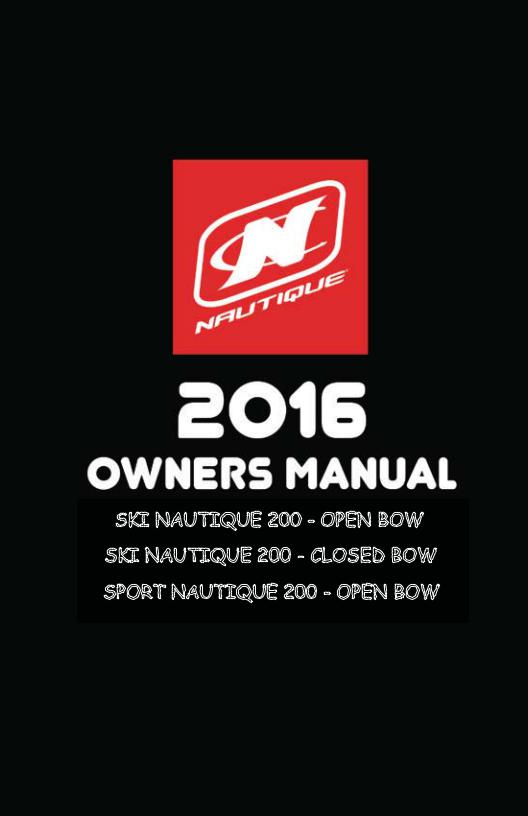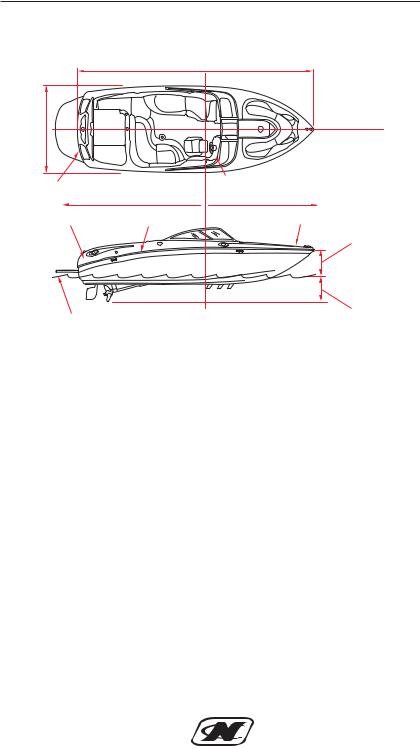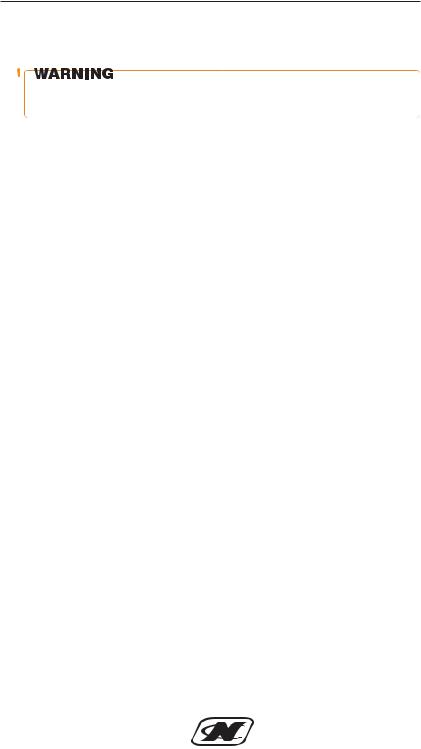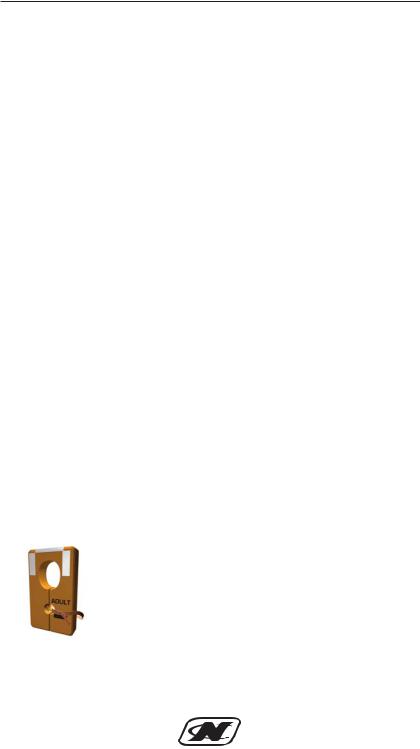Nautique Sport Nautique 200, SKI Nautique 200 User Manual

SKI NAUTIQUE 200 - OPEN BOW
SKI NAUTIQUE 200 - CLOSED BOW
SPORT NAUTIQUE 200 - OPEN BOW

Dear Nautique Owner,
Welcome to the Nautique Family! For over 90 years, Nautique has been dedicated to providing our customers and their families with the finest inboard boats available. It’s our passion to create the best performing boats in the industry. Boats that allow you to escape the routine of everyday life. Our customers don’t just own a Nautique, they live the Nautique life.
Your boat has been built with the best material and workmanship available, a legacy handed down from our founder. Our wealth of experience gives us the edge in innovation, quality and performance. We have the most dedicated and loyal employees in the industry. Hands down. Every day, our employees do more than just punch a clock; they take personal pride in every boat that comes down the line.
Review this Owner’s Manual for your boat. We have assembled this manual to inform you about your Nautique and educate you further on boating. Please pay particular attention to the safety statements labeled as DANGER, WARNING, CAUTION and NOTICE. These statements alert you to possible safety hazards to avoid so you can have a safer boating experience. There are also many tips and tricks on care and maintenance sprinkled throughout the manual. Boating is very important to us and we would like you to enjoy many years of boating in your Nautique.
By purchasing a Nautique, you have taken the first step in trading your old lifestyle for a new one. Now that you own a Nautique, life as you know it will never be the same.
Enjoy the Nautique Life.
The Nautique Team
Trust in the Lord with all thine heart; and lean not unto thine own understanding. In all thy ways acknowledge him, and he shall direct thy paths.
Proverbs 3:5-6
P/N 160055 |
i |

Record Important Information
In addition to this manual, your Nautique boat is supplied with component manufacturer information such as instructions, warranties or other important information. Read these materials carefully since improper operation and maintenance can void the warranty and jeopardize personal safety.
Safeguard information about your Nautique boat, by recording the Hull Identification Number (HIN) and the model of your boat, and the model and serial numbers of your engine/transmission and trailer, if applicable.
Your HIN is located on the top right side of the transom, above the water line. The U.S. Coast Guard requires that your HIN be permanently affixed and remain on the top right side of the transom. The first two digits refer to the country of manufacture (U.S.). The next three digits represent the manufacturer, Nautique Boat Company, Inc. (CTC). The next five digits are the boat’s serial number. The next digit is a letter from “A” where “A” = January through “L” where “L” = December, designating the month the boat was made.
The last three digits represent the last digit of the year the boat was built and the final two digits of the boat model year. A boat built in July 2006 is actually a 2007 model boat. Example: A boat with “607” as the last digits indicates the boat was built in 2006, but it is a 2007 model boat.
Hull
HIN ___________________________________________________________
Date Purchased _________________________________________________
Dealer/Phone __________________________________________________
Ignition Key Number ____________________________________________
Registration Number/State _______________________________________
Engine
Model Number _________________________________________________
Serial Number __________________________________________________
Trailer
Model Number _________________________________________________
Serial Number __________________________________________________
Accessory
Model Number _________________________________________________
Serial Number __________________________________________________
The identification numbers are important! Keep a copy of these numbers stored in a safe place off the boat. In case of theft, damage, etc., report these numbers to the local authorities, your insurance agent and your Nautique dealer.
ii

Boater’s Checklist
For improved safety and enjoyment, check each of these items:
Check Before You Launch Your Boat:
•Read both the engine and the boat operator manuals.
•Drain plug (Securely in place?)
•Propeller Condition (Prop nut tight and secured, no cracked or bent blades, prop turns freely?)
•Steering System (Working smoothly and properly, self locking nuts in place?)
•Battery (Fully charged, cable terminals clean and tight?)
•Capacity Plate (Are you overloaded?)
•Weather conditions (Safe to go out?)
•Fuel and Oil (Sufficient for trip, check bilge area for gas odor, no leaks?)
•Hoses and Connectors (No leaks or damage?)
•Electrical Equipment (Lights, horn, pumps, etc.?)
•Safety Equipment (Fire extinguisher, bailer, paddle, anchor and line, mooring lines, signaling device, tool kit, first aid kit, first aid manual?)
•Personal Flotation Devices for all occupants
•Float Plan submitted to Responsible Person (Verbal or written?)
Check Before You Start Your Engine:
•Fuel (Sufficient for trip, check bilge area for gas odor?)
•Control Lever in Neutral
•Capacity Plate (Are you overloaded?)
•Personal Flotation Devices for all occupants
•Seating (Everyone in proper place?)
•Engine Stop Switch and Lanyard (Operational and securely fastened?)
•No one in water near boat
•Keep firm and continuous grip on steering wheel
•Engine Cooling Water Valve open
iii

Restricted Areas
Before boating, check with Local, State and Federal authorities to identify restricted areas. Because of the threat of terrorism, the U.S. Coast Guard has and will continue to implement strict limits on watercraft near U.S. Navy and Coast Guard ships and other potential targets.
Proposition 65
A wide variety of components used on this vessel contain or emit chemicals known to the State of California to cause cancer and birth defects and other reproductive harm.
EXAMPLES INCLUDE:
Engine and generator exhaust.
Engine and generator fuel, and other liquids such as coolants and oil, especially used motor oil. Cooking fuels.
Cleaners, paints and substances used for vessel repair. Waste materials that result from wear of vessel components.
Lead from battery terminals and from other sources such as ballast or fishing sinkers.
TO AVOID HARM:
Keep away from engine, generator and cooking fuel exhaust fumes.
Wash area thoroughly with soap and water after handling the substances above.
California Health & Safety Code 25249.5-.13
KC-0206-B
Emission Control Warranty
Information
The engine in your Nautique boat meets the strict requirements set forth by the California Air Resources Board (CARB). The engine has a special environmental tag and the boat has this
label affixed to it. The tag and the label are CORC013 required by the California Air Resources Board
(CARB). The label has 1, 2, 3 or 4 stars. The label MUST be affixed to the boat, if the boat is operated in the state of California and/or bordering waters.
iv

Boating Terminology
|
LENGTH OVERALL (LOA) |
|
BEAM |
|
PORT |
|
SIDE |
|
|
STARBOARD |
|
|
|
SIDE |
TRANSOM |
HELM |
|
|
|
|
|
AFT |
FORWARD |
STERN |
GUNWALE |
BOW |
|
|
FREEBOARD |
DRAFT
WATERLINE
CORC001
* An easy way to remember PORT side from STARBOARD side is “PORT” and “LEFT” both have four letters.
Product Improvement
Because of our policy of continuous product improvement, the illustrations used in this manual may not look the same as on your boat and are intended only as representative reference views. Some illustrations may also show optional accessories which may or may not be available for your boat. Many optional accessories can only be installed at the time the boat is manufactured and cannot be installed by your dealer. Your dealer will be happy to provide details on installing accessories.
v

Table of Contents
Welcome..................................... |
i |
Record Important |
|
Information............................... |
ii |
Boater’s Checklist.................... |
iii |
Restricted Areas ....................... |
iv |
Proposition 65.......................... |
iv |
Emission Control Warranty |
|
Information .............................. |
iv |
Boating Terminology................ |
v |
Product Improvement.............. |
v |
Boating Safety ...................... |
1-1 |
Introduction........................... |
1-1 |
About this Owner’s |
|
Manual ................................ |
1-2 |
Signal Words and Symbols |
|
Used In This Manual ......... |
1-3 |
Basic Safety Rules .................. |
1-4 |
Pre-operation Check |
|
List – Before Leaving |
|
the Dock.............................. |
1-5 |
Precautions While |
|
Underway ............................ |
1-7 |
Safety While Maintaining |
|
the Vessel .......................... |
1-10 |
Owner Responsibility and |
|
Boating Education............... |
1-12 |
Important Safety |
|
Information ...................... |
1-12 |
Responsibilities of Boat |
|
Owner and Operators...... |
1-12 |
Registration....................... |
1-13 |
Insurance .......................... |
1-13 |
Boating Safety Education |
|
Opportunities ................... |
1-14 |
Operation by Minors |
|
and Licensing ................... |
1-15 |
Safety and Required |
|
Equipment ........................... |
1-15 |
Navigation Lights ............. |
1-16 |
Emergency Safety |
|
Lanyard ............................. |
1-16 |
Personal Flotation |
|
Devices............................... |
1-18 |
Fire Extinguisher.............. |
1-20 |
Horn or Whistle ............... |
1-20 |
Bilge Pump(s)................... |
1-21 |
Visual Distress Signals ...... |
1-21 |
Recommended Safety |
|
Equipment ........................ |
1-22 |
General Boating Safety |
|
Topics ................................... |
1-23 |
Safe Speed......................... |
1-23 |
Passenger Safety ............... |
1-23 |
Carbon Monoxide |
|
Safety ................................. |
1-24 |
Proper Loading ................ |
1-27 |
Weighting Your Boat |
|
During Watersport |
|
Activities ............................ |
1-28 |
Visibility from the Helm ... |
1-30 |
Boating Under the |
|
Influence ........................... |
1-31 |
Product Misuse ................. |
1-32 |
Reporting Accidents ........ |
1-32 |
Rendering Assistance ....... |
1-32 |
Hazardous Conditions ..... |
1-33 |
Environmental |
|
Concerns ........................... |
1-34 |
On Product Warning |
|
Labels.................................... |
1-37 |
Warning Labels & |
|
Locations........................... |
1-37 |
Basic Rules of the Road ...... |
1-50 |
vi

Boating Regulations......... |
1-50 |
Encountering Another |
|
Vessel ................................. |
1-51 |
Aids to Navigation ............ |
1-55 |
Night Running ................. |
1-61 |
Watersports Safety ............... |
1-64 |
Hand Signals..................... |
1-66 |
Towed Person Safety |
|
Responsibilities ................. |
1-66 |
Additional Precautions |
|
for Towed Skier/Rider .... |
1-68 |
Tow Line Guidelines........ |
1-70 |
Fallen Skier or Rider........ |
1-71 |
Develop WATER SENSE .. |
1-72 |
Emergency Procedures ....... |
1-77 |
Explosion and Fire........... |
1-77 |
Swamping and Flooding..1-78 |
|
Capsizing ........................... |
1-79 |
Staying Afloat.................... |
1-79 |
Collisions........................... |
1-79 |
Grounding ........................ |
1-80 |
Person Overboard ............ |
1-80 |
Drowning .......................... |
1-81 |
Medical Emergency.......... |
1-81 |
Operation Failure............. |
1-81 |
Towing............................... |
1-81 |
200-OB, 200-CB, 200-V......... |
2-1 |
Specifications ......................... |
2-1 |
200-OB, 200-CB .................. |
2-1 |
200-V.................................... |
2-1 |
200 Nautique Dash Pod and |
|
Console................................... |
2-3 |
200-OB, 200-CB Team Dash |
|
Pod and Console ................... |
2-5 |
Keys ......................................... |
2-5 |
200-V Team Dash Pod and |
|
Console................................... |
2-7 |
Keypad .................................... |
2-9 |
200 Open Bow Deck |
|
Layout ................................... |
2-10 |
200 Closed Bow Deck |
|
Layout ................................... |
2-12 |
200 V-Drive Deck Layout .... |
2-14 |
200-OB Seating Area ........... |
2-16 |
200-CB Seating Area............ |
2-17 |
200-V Seating Area .............. |
2-18 |
Standard and Optional |
|
Equipment ........................... |
2-19 |
Controls and Indicators ....... |
3-1 |
Steering .................................. |
3-1 |
Hydro-Gate™ Control and |
|
SportShift™............................ |
3-2 |
Shifter/Throttle..................... |
3-4 |
Emergency Stop Switch ..... |
3-5 |
Nautique Dash Pod ............... |
3-6 |
Gauges ................................. |
3-6 |
Speedometer Calibration |
..3-8 |
Control Switches................. |
3-8 |
12-Volt Port ....................... |
3-11 |
Nautique Digital |
|
Cruise ................................ |
3-12 |
Team Dash Pod ................... |
3-15 |
Keypad............................... |
3-15 |
Switches ............................. |
3-20 |
Nautique LINC 2.0.............. |
3-22 |
Product Information........ |
3-22 |
Basic Navigation |
|
Features ............................. |
3-23 |
Quick Access Key |
|
Features ............................. |
3-24 |
Nautique LINC 2.0 – River |
|
Mode ................................. |
3-44 |
Nautique LINC 2.0 – River |
|
Mode in Integrated |
|
Zero Off 3 Event............... |
3-52 |
MENU Options ................ |
3-55 |
vii

LINC 2.0 General |
|
Troubleshooting Guide ... |
3-63 |
Standard Equipment........... |
3-64 |
Watersports Tow Point .... |
3-64 |
Tow Rope Attachment – |
|
Center................................ |
3-65 |
Tow Rope Attachment – |
|
Tower Pylon...................... |
3-66 |
Bow Features - Open |
|
Bow Only........................... |
3-67 |
Driver’s Seat |
|
Adjustment........................ |
3-68 |
Rearview Mirror |
|
Adjustment........................ |
3-69 |
Observer’s Seat ................. |
3-70 |
200 Engine Box Cover/ |
|
Lifting/Removal............... |
3-71 |
Walk-Thru Windshield |
|
Opening/Latching........... |
3-72 |
Dash Storage..................... |
3-72 |
Boarding Platform ........... |
3-73 |
Engine Cooling Water |
|
Intake Valve ...................... |
3-75 |
Battery Disconnect |
|
Switch ................................ |
3-76 |
Nautique Electrical |
|
System................................ |
3-76 |
Rudder Remote Lube ...... |
3-76 |
Fuel Tank .......................... |
3-77 |
Optional Equipment ........... |
3-78 |
Folding Instructions for |
|
Flight Control Tower®...... |
3-78 |
Bimini Top........................ |
3-80 |
Battery Charger ................ |
3-81 |
Optional Accessories ........... |
3-81 |
Stereo Systems .................. |
3-81 |
Boat Systems ........................ |
4-1 |
Fuel System ............................ |
4-1 |
200-OB, 200-CB .................. |
4-2 |
200-V.................................... |
4-3 |
Ballast Tanks and Bilge |
|
System ..................................... |
4-4 |
Ballast Tank Valves – |
|
200-V.................................... |
4-5 |
Port and Starboard |
|
Ballast Tanks – 200-V ......... |
4-6 |
Bilge System – 200-OB, |
|
200-CB, 200-V...................... |
4-7 |
12-Volt System – 200-OB, |
|
200-CB .................................... |
4-8 |
12-Volt System – 200-V |
|
Only ........................................ |
4-9 |
Cockpit Heater System – |
|
Optional ............................... |
4-10 |
Getting Underway ................ |
5-1 |
Safety Checklist ...................... |
5-1 |
Safety Equipment .................. |
5-2 |
Fueling.................................... |
5-2 |
Gasoline Containing |
|
Alcohol ................................ |
5-3 |
When Fueling ..................... |
5-4 |
After Fueling....................... |
5-5 |
Boarding................................. |
5-5 |
Boat Planing........................... |
5-5 |
Pre-Operation Checks........... |
5-6 |
Flooded Engine................ |
5-11 |
Break In Procedure.......... |
5-13 |
Propeller Selection........... |
5-13 |
Shifting ................................. |
5-14 |
Steering ................................ |
5-14 |
Stopping ............................... |
5-15 |
Docking ................................ |
5-15 |
Running................................ |
6-1 |
Hydro-Gate™.......................... |
6-1 |
Maneuvering Techniques ..... |
6-2 |
viii

Tow Pattern............................ |
6-3 |
Freezing Temperatures......... |
6-4 |
Anchoring .............................. |
6-4 |
Dropping Anchor............... |
6-5 |
Weighing (Pulling In) |
|
Anchor................................. |
6-5 |
Performance Boating ............ |
6-6 |
Propellers ............................... |
6-6 |
Care and Maintenance ......... |
7-1 |
General Maintenance............ |
7-1 |
Engine Intake Raw Water |
|
Strainer................................ |
7-2 |
Bilge Pumps ........................... |
7-4 |
CE Bilge Discharge Filter...... |
7-4 |
Cartridge Replacement...... |
7-5 |
Ballast Filtration System |
|
(optional) ............................... |
7-6 |
Propeller................................. |
7-7 |
Removal............................... |
7-7 |
Installation .......................... |
7-8 |
Through-Hull Fittings ........... |
7-8 |
Quick Oil Drain System ........ |
7-9 |
Salt Water Boating............... |
7-10 |
Freshwater Flushing Kit - |
|
Optional ............................... |
7-10 |
Proper Use of Freshwater |
|
Flushing Kit....................... |
7-10 |
Coastal Edition..................... |
7-11 |
Battery Maintenance ........... |
7-12 |
Battery Cable Warning |
|
Alarm................................. |
7-14 |
Gelcoat Maintenance .......... |
7-15 |
Care of Metal ....................... |
7-16 |
Care of Glass ........................ |
7-17 |
Adhesive-Backed |
|
Non-Skid............................... |
7-17 |
Vinyl Maintenance and |
|
Cleaning ............................... |
7-17 |
Tunable Rudder .................. |
7-19 |
Rudder Remote Lube |
|
Fitting ................................ |
7-20 |
Checking Transmission |
|
Fluid...................................... |
7-20 |
Checking V-Drive Unit |
|
Fluid (200-V Only) .............. |
7-21 |
Troubleshooting................... |
8-1 |
Trouble Check Chart ............ |
8-2 |
Performance ....................... |
8-2 |
Electrical.............................. |
8-3 |
Storage ................................. |
9-1 |
Lifting Rings........................... |
9-1 |
Winterizing Your Boat........... |
9-3 |
Winterizing the Heater |
|
System (in Closed-Cooled |
|
Engines Only)..................... |
9-4 |
Check for Water in Your Fuel |
|
System ..................................... |
9-5 |
Trailer/Trailering ................. |
9-7 |
Hitch.................................... |
9-7 |
Wiring.................................. |
9-7 |
Security................................ |
9-7 |
Towing Your Boat .............. |
9-8 |
Long Trips .......................... |
9-9 |
Glossary............................... |
G-1 |
Warranty ............................. |
W-1 |
NAUTIQUE LIMITED |
|
WARRANTY.......................... |
W-1 |
Lifetime Limited |
|
Warranty ............................ |
W-1 |
Transferable Lifetime |
|
Limited Warranty.............. |
W-1 |
Boat Five (5) Year |
|
Transferable Limited |
|
Warranty ............................ |
W-2 |
ix

Gel Coat Three (3) Year |
|
Transferable Limited |
|
Warranty ............................ |
W-2 |
Engine/Power Train |
|
Warranty ............................ |
W-2 |
Exceptions ......................... |
W-2 |
Procedure .......................... |
W-4 |
NAUTIQUE COASTAL |
|
EDITION LIMITED |
|
WARRANTY.......................... |
W-5 |
Lifetime Limited |
|
Warranty ............................ |
W-5 |
Transferable Lifetime |
|
Limited Warranty.............. |
W-5 |
Boat Three (3) Year |
|
Transferable Limited |
|
Warranty ............................ |
W-6 |
Gel Coat One (1) Year |
|
Transferable Limited |
|
Warranty ............................ |
W-6 |
Engine/Power Train |
|
Warranty ............................ |
W-6 |
Exceptions ......................... |
W-7 |
Procedure .......................... |
W-9 |
x

Section 1
Boating Safety
Introduction
Congratulations on your purchase of a new high-performance recreational tow boat. Your Nautique boat has been constructed to meet and/or exceed all U.S. Coast Guard (USCG) and National Marine Manufacturers Association (NMMA) requirements applicable at the time of its manufacture. However, it is still your responsibility as the boat owner to ensure the boat is operated in a safe manner and is properly maintained.
Before operating this vessel, please take the time to get acquainted with the vessel and its various features and controls. We recommend that you carefully read and familiarize yourself with this Owner’s Manual and all on-product safety labels prior to operating your new watercraft. This manual contains important information on Boating Safety, Boating Rules, Proper Operation and Maintenance of your boat. This manual provides a guideline for proper operation and maintenance of your boat, and you should consider it a permanent part of your vessel. In the event that this boat is sold, this manual should be included along with the boat to ensure that it will provide the same important information to the next owner.
1-1

Section 1
About this Owner’s Manual
The recommended practices and warnings in this manual represent sound advice for recreational boating and identify common risks encountered by boaters engaging in towed watersport activities. Read and understand the contents of this manual. Ask questions of a boating professional if anything in this manual does not make sense to you. The manual does not cover all instances of risk or danger, so please use common sense and good judgment when boating. If you follow the advice provided in this manual you will significantly reduce risk to yourself, your passengers, towed participants, and other boaters.
This manual is not intended to be a substitute for taking a course on boating safety nor is it a substitute for boating experience. It is recommended that if you are unfamiliar with the use and operation of a boat you seek advice and training from a qualified individual or organization. Check with your local marine law enforcement agency or dealer for more information about boating safety classes in your area.
The precautions listed in this manual and on the boat are not allinclusive. If a procedure or method is not specifically recommended, YOU must be satisfied that it is safe for you and your passengers, and that the boat will not be damaged or made unsafe as a result of your decision. Remember - always use caution and common sense when operating and maintaining your boat!
1-2

Boating Safety
Signal Words and Symbols Used In This Manual
Throughout this manual specific precautions and symbols identify safety-related information. You will find DANGER, CAUTION, WARNING, NOTICE and SAFETY INSTRUCTIONS symbols which require special attention. Please read them carefully and follow these precautions as indicated! They will explain how to avoid hazards that may endanger you, your passengers, towed participants, and other boaters. PLEASE REVIEW ALL SAFETY
INFORMATION.
 DANGER indicates a hazardous situation which, if not avoided, will result in death or serious injury.
DANGER indicates a hazardous situation which, if not avoided, will result in death or serious injury.
 WARNING indicates a hazardous situation which, if not avoided, could result in death or serious injury.
WARNING indicates a hazardous situation which, if not avoided, could result in death or serious injury.
 CAUTION CAUTION indicates a hazardous situation which, if not avoided, could result in minor or moderate injury.
CAUTION CAUTION indicates a hazardous situation which, if not avoided, could result in minor or moderate injury.
NOTICE is used to address practices not related to physical injury.
SAFETY INSTRUCTIONS (or equivalent) signs indicate specific safety-related instructions or procedures.
1-3

Section 1
Basic Safety Rules
Make sure you understand all of the operating instructions prior to attempting to operate this boat. Boating-related accidents are generally caused by the operator’s failure to follow basic safety rules or written precautions. Most accidents can be avoided if the operator is completely familiar with the boat and its operation, follows recommended practices, and is able to recognize and avoid potentially hazardous situations.
 Failure to adhere to these warnings may result in severe injury or death to you and/or others.
Failure to adhere to these warnings may result in severe injury or death to you and/or others.
Past accident data shows that most FATALITIES involve actions which cause falls or ejections overboard, mishaps with towed persons, propeller strikes, collisions, and carbon monoxide exposure.
Past accident data shows that most INJURIES are associated with collisions, mishaps with towed persons, falls or ejections overboard, being struck by the propeller, and fires and explosions.
These incidents are mostly caused by operator inattention, operator inexperience, reckless operation, alcohol/drug use, excessive speed, passenger or towed person behavior, and violation of navigation rules.
Failure to observe the safety recommendations contained in this manual may result in severe personal injury or death to you or to others. Use caution and common sense when operating your boat. Don’t take unnecessary chances! Basic safety rules are outlined in this section of the manual.
1-4

Boating Safety
Pre-operation Check List - Before Leaving the Dock
 Failure to follow these precautions may result in severe injury or death to you and/or others.
Failure to follow these precautions may result in severe injury or death to you and/or others.
The operator shall:
•Check that weather conditions are safe for boating. It is the driver’s responsibility to determine if weather or other factors have created an unsafe boating environment. Boaters must continuously be aware of weather conditions. Sudden storms, wind, water conditions, lightning, etc., can unexpectedly put boaters in grave danger. Always check the local weather report before going boating.
•Check that drain plugs are securely in place.
•Check bilge pump, horn, lights, blower and other equipment to verify they are operating properly.
•Verify that the emergency cutoff switch lanyard is in proper operating condition and is properly affixed to the driver.
•Check the operation of the steering system. Verify that the steering is operational before launching the boat. If the boat is already in the water, verify proper steering wheel operation at low speed. Turn the steering wheel full stop in both directions and verify proper rudder movement. Ensure that there is no binding or stiffness in the steering wheel rotation. Binding and stiffness is an indication that the steering cable needs replacement. Failure of the steering cable will result in loss of control of the boat.
•Ensure that the load of persons, ballast, and equipment is within the limits stated on the USCG Maximum Capacities Plate and is properly distributed based on instructions in this manual.
•Check that all safety equipment and life jackets, personal flotation devices (PFDs), and throwable cushions are in good condition and suitable for your boat and passenger load.
•Inform all passengers where safety equipment is located and how to use it.
1-5

Section 1
•Have at least one other passenger who is capable of operating the boat safely in case of an emergency.
 Gasoline vapors can explode. Before starting engine operate blower for 4 minutes and check engine compartment bilge for gasoline vapors.
Gasoline vapors can explode. Before starting engine operate blower for 4 minutes and check engine compartment bilge for gasoline vapors.
•It is very important to open the engine cover and check the engine compartment and bilge for liquid gasoline and gasoline vapors prior to each use of your boat and after refueling. Failure to do so may result in fire or explosion as well a serious injury or death to you and/or others.
•If you see liquid gasoline in the engine compartments/ bilge or smell gasoline vapors, DO NOT attempt to start the engine. Liquid gasoline in the bilge is an extreme fire and explosion hazard which may cause injury or death. Find and fix the source of the leakage, remove the liquid gasoline from the bilge. Then ventilate the engine compartment/bilge and run the blower to remove all gasoline vapors before starting the engine.
If gasoline vapors persist after running the blower, DO NOT attempt to start the engine. Look for a cause and remedy before starting the engine.
•Always operate blower below cruising speed and after stopping the boat.
1-6

Boating Safety
Precautions While Underway
 Failure to follow these precautions will result in serious injury or death.
Failure to follow these precautions will result in serious injury or death.
The operator shall:
•Check that the area behind the boat is all clear before starting the engine to AVOID PROPELLER INJURY to persons in the water behind the boat or on the swim platform.
•Turn off the engine prior to anyone occupying the swim platform or being in the water behind the boat to AVOID PROPELLER INJURY. Being in neutral gear is insufficient; the propeller may still be turning, or engine may be inadvertently shifted into gear.
•Not back the boat toward persons in the water behind the boat to AVOID PROPELLER INJURY.
•Not allow people to be on or near the swim platform or in the water near or around the swim platform while the engine is running because CARBON MONOXIDE will exist around the back of the boat when the engine is running. Engine exhaust contains carbon monoxide, which is a deadly, odorless, colorless gas.
•Not operate the engine in a confined space or while tethered to another vessel as CARBON MONOXIDE will be around the boats.
•Not go under the boat cover with the engine running or shortly after the engine has been running because CARBON MONOXIDE may remain under the cover. Remove cover to ventilate the area.
 Failure to follow these precautions may result in severe injury or death to you and/or others.
Failure to follow these precautions may result in severe injury or death to you and/or others.
1-7

Section 1
The operator shall:
•Follow safe operating practices, the “Rules of the Road”, and the Watersports Responsibility Code.
•Not operate a boat if under the influence of alcohol or other drugs.
•Attach the emergency cutoff switch lanyard to his person when operating the boat.
•Maintain a proper course and safe speed at all times to avoid collisions.
•Maintain a lookout for other boats, swimmers and obstructions in the water.
•Operate slowly in congested areas such as marinas and mooring areas.
•Keep a safe distance from other boats, swimmers, personal watercraft, docks, and fixed objects.
•Look before you turn/maneuver the boat so as to avoid potential collisions with oncoming or overtaking vessels.
•Be aware that this boat is a high-performance boat and is capable of quick, tight turns and changes in direction. Familiarize yourself with the handling characteristics of the boat. It is the operator’s responsibility to operate the boat in a manner that ensures the safety of all passengers. Abrupt maneuvers may result in the ejection of unsecured, unseated, or improperly positioned passengers. Verbally warn passengers before making quick, tight turns so they may have time to grasp a handrail, hand-hold, or portion of the boat.
•Be aware that your boat will handle differently depending on loading and on-board weight distribution.
•Ensure that all passengers are properly and securely seated in appropriate seating locations to avoid falling or falling overboard.
•Instruct and ensure that passengers remain properly seated at all times while the boat is in motion above idle speed.
•Not allow passengers to sit on the transom, seat backs, engine cover or sides of the boat while the engine is running and the boat is in motion to avoid falling overboard.
•Not allow passengers to sit in a position that obstructs the operator’s view.
1-8

Boating Safety
•NEVER leave children unattended and in the boat without adult supervision.
•Have children riding in the bow of the boat be accompanied by an adult in the bow and ensure that all remain seated when the boat is in motion.
•Not let passengers occupy seats which may be in the path of the tow line.
•Slow down when crossing waves or wakes in order to minimize the impact on passengers and the boat. Crossing waves or wakes at an angle (such as 45 degrees) rather than perpendicularly will reduce the severity of the impact. Avoid rough water, large waves and large wakes from other boats when at high speed. Jumping waves/wakes or slamming the bow will cause large vertical impacts which may cause injury to occupants or cause ejections.
•For safe towing (waterskiing, tubing, wakeboarding, wake surfing, knee boarding, etc.) be experienced and have an observer [an observer or “spotter” is required by law in most states]. A rear view mirror is helpful if you are allowed to tow without an observer in your state.
•Avoid letting tow lines or mooring lines wrap around anyone’s body parts/limbs. Doing so could allow body parts/ limbs to become entangled in the line and could cause significant injury, such as amputations.
•Keep track of tow lines and dock lines so that they do not become entangled in the propeller. A tow line will wrap quickly around a spinning propeller and is capable of immobilizing the boat and dragging a person entangled in the tow line underwater or causing amputations. Shut off the engine if a tow line has potential for wrapping in the propeller.
•The tower is designed to pull a limited number of individual(s), and in some cases only one (1) individual. Please consult the remainder of this manual and warning labels on the tower for details. DO NOT climb, sit on, stand on or jump/dive off of the tower. Tow line may loop on inverted tricks. DO NOT sit behind the pulling point of the tower.
1-9

Section 1
•NEVER allow any type of spark or open flame near gasoline or engine compartment.
•Avoid grounding the boat: be familiar with local conditions and water depth. If you are uncertain, then proceed slowly with caution. Sudden groundings from planing speeds may cause rapid decelerations and cause occupants to impact the boat and/or to be ejected from the boat. Boat damage may also occur.
•Always watch for low obstacles such as tree limbs, bridges or power lines, especially in boats with tow towers.
•Seek shelter from open water if there is threat of lightning or severe weather.
•NEVER dive from the boat without being absolutely sure of the depth of the water. Severe injury or death may occur from striking the bottom or submerged objects. Striking the bottom or a submerged object while diving head first can cause paralysis, head injury or death.
•Provide assistance to other boaters in distress while ensuring the safety of your own passengers.
•When you leave the boat, take the keys with you. This will keep untrained and unauthorized persons from operating the boat. (This may not be applicable on some keyless ignition systems.)
Safety While Maintaining the Vessel
 Failure to follow these precautions may result in severe injury or death to you and/or others.
Failure to follow these precautions may result in severe injury or death to you and/or others.
The operator shall:
•Visually inspect the engine compartment and ventilate after refueling.
•Inspect fuel system regularly. Examine fuel tanks, hoses and fittings for leaks or corrosion at least annually because leaking fuel is a fire and explosion hazard.
1-10

Boating Safety
•Never remove or modify components of the fuel system in any way except for maintenance by qualified personnel. Tampering with fuel components may cause a hazardous condition which could lead to a fire or explosion.
•Never override or modify the engine neutral starting safety switch in any way. Your boat engine should not start in gear. If it does, do not use the boat and have this safety feature fixed by an authorized dealer.
•When charging some batteries, a small amount of hydrogen gas is generated. Hydrogen gas is highly explosive. While charging, it is a good idea to keep sparks, flames and smoking away from the battery. Failure to follow instructions when charging a battery may cause an explosion of the battery.
•Keep the engine off whenever the engine box/cover/hatch is open. The engine box/cover/hatch serves as a machinery guard. Clothing or body parts can get caught in moving parts, causing death or serious injury. Keep away from moving parts.
•Not replace your boat’s marine parts with automotive parts or parts that were not designed for your boat.
•Be aware that battery electrolyte fluid is dangerous. It contains sulfuric acid, which is poisonous, corrosive and caustic. If electrolyte fluid is spilled or placed on any part of the human body, immediately flush the area with large amounts of clean water and immediately seek medical attention.
•Check the tightness of the tower bolts BEFORE each use. If a tower collapses it may result in injury to boat occupants or towed persons.
•Not modify the tow bar. The tow pylon/bar is not designed for vertical extensions. Any modifications to the tow pylon/ bar or its mountings may result in damage to the boat and injury to the user.
•Only lift the boat from approved lift points, which are identified in later parts of the manual.
1-11

Section 1
Owner Responsibility and
Boating Education
Important Safety Information
Your safety, the safety of your passengers, and the safety of other boaters is dependent on how you operate and maintain your boat. As operator or owner of this boat, you are responsible for the safety of those with and around you while boating.
Responsibilities of Boat Owner and Operators
It is the owner’s responsibility to ensure that the operator of the boat has been properly instructed in the lawful and safe operation of this vessel. Therefore, before operating the boat, thoroughly read this owner/operator manual. Be sure you understand each item before operating it. Improper operation or trailering of the boat could lead to severe personal injury or death. Improper operation or trailering of the boat may also damage the boat.
The operator and the boat owner assume all risks for themselves, their guests and anyone in proximity to their boat and ensure that all passengers understand the risks and responsibilities associated with boating.
This manual is not intended to provide complete training on all aspects of boat operation. We strongly recommend that all operators of this boat seek additional training on boat handling and safety. Have all operators become familiar with the handling characteristics, and proper steering and control system usage before attempting high-speed operation.
At the time of delivery, the owner/operator is responsible for:
•Understanding the warranty terms and conditions of your boat, your engine, and your trailer.
•Obtaining insurance.
•Examining the boat to ensure the proper operation of all systems.
1-12

Boating Safety
Before operating the boat, the owner/operator is responsible for:
•Registering the boat as required in the jurisdiction where the boat is being operated.
•Providing the proper (USCG) safety equipment, and checking local, state and federal agencies as to laws and regulations (USCG carriage requirements).
•Carefully reading and understanding safety information and proper operating procedures within this manual.
•Obtaining other boating education if you lack operational experience.
•Familiarizing yourself with the navigable waters where you intend to operate the boat.
•Following the proper break-in procedure for the engine.
Registration
Federal Law requires that all motorboats be registered and that all motorcraft not documented by the U.S. Coast Guard display registration numbers. In nearly all states, this means registration with the designated state agency. In a few jurisdictions, the Coast Guard retains registration authority. Your dealer will either supply registration forms or tell you where they may be obtained. The agency will supply you with a certificate which must be carried with you when the boat is in operation. International laws may vary as to required registration.
Insurance
The boat owner may be legally responsible for damages or injuries caused by both himself and the operator (if different than the owner). Common sense dictates that you carry adequate personal liability and property damage insurance on your boat, just as you would on your automobile. Many states have laws detailing minimum insurance needs. Your insurance agent or your dealer may be able to supply you with more information. You should also protect your boat from physical damage or theft.
1-13

Section 1
Boating Safety Education Opportunities
It is recommended that the boat owner/operator obtain boater safety education. If you have never owned a boat before, you can get an excellent introduction to boat handling from organizations such as the U.S. Coast Guard, American Red Cross, United States Coast Guard Auxiliary, or your local boating authority. Even if you are a veteran boater, these courses will help sharpen your boating skills as well as bring you up to date on current rules and regulations. See your local boating agency or dealer for information on classes in your area.
Some states require youths, 16 years of age and younger, to complete a boating safety course before operating any watercraft. Many others require operators under the age of 18 to be licensed in small boat operation.
Boat smart from the start: take a boating safety course and get a free vessel safety check annually for your boat. For more information, contact: United States Coast Guard Auxiliary, www.cgaux.org; United States Power Squadrons, 1-888-FOR-USPS, www.usps.org.
The following is a list of some other agencies and organizations that offer Water Safety, First Aid and CPR courses or information. To find boating safety courses in your area, call your state’s local boating agency or the USCG boating safety course line at 1-800-336-2628 (1-800-245-2628 in Virginia).
•USCG Office of Boating ( www.uscgboating.org )
•American Red Cross ( www.redcross.org )
•U.S. Coast Guard Auxiliary ( www.cgaux.org )
•U.S. Power Squadrons ( www.usps.org )
•State Boating Offices
•Canadian Power and Sail Squadrons ( www.cps-ecp.ca )
•Boat Owners Association of the United States ( www.boatus.com )
•National Safe Boating Council (www.safeboatingcouncil.org)
•Water Sports Industry Association ( www.wsia.net )
•European or international organizations
1-14

Boating Safety
Operation by Minors and Licensing
If your boat will be operated by a minor, remember to have an adult present at all times. Many states have laws regarding minimum age and licensing requirements for minors. Some states require boat training courses, certification,or licensing for minors and/or adults. Contact state and local authorities for requirements that apply in your area.
Safety and Required
Equipment
Your boat and equipment must be in compliance with federal, state and local safety equipment regulations. USCG regulations require certain safety equipment be present on your boat during operation. For a detailed description, obtain “Federal Requirements for Recreational Boats” published by the U.S. Coast Guard and available online at: http://www.uscgboating.org/regulations/federal_requirements_ brochure.aspx.
In addition to the USCG regulations, other local and/or international law enforcement agencies may have similar requirements. You should check with your local marine law enforcement agency regarding any such requirements before boating.
Equipment requirements for coastal and inland waters differ. Check with local authorities and/or the USCG for further information about coastal water requirements.
The Federal Boat Safety Act of 1971 (FBSA/71) and the National Recreation Boating Safety Program have established minimum safety standards for boats and associated equipment, specified by the USCG. In addition, the American Boat and Yacht Council (ABYC) and the National Marine Manufacturers Association (NMMA) work with boat builders to develop voluntary standards that exceed the USCG requirements. The included safety equipment on your boat meets or exceeds the standards of the USCG, ABYC and the NMMA.
1-15

Section 1
Some required safety equipment, such as life jackets (PFDs), are not included with your boat. Your dealer can help you choose the appropriate equipment.
Many states’ equipment requirements go beyond USCG requirements. Contact your state boating office for further information.
Navigation Lights
Your boat is equipped with navigational lights. Recreational boats are required to display navigational lights between sunset and sunrise and other periods of reduced visibility (fog, rain, haze, etc.). Navigation lights are provided to keep other boats informed of your presence and course. It is up to you to make sure they are operational, displayed correctly, and turned on when required.
Emergency Safety Lanyard
Your boat is equipped with an Emergency Safety Lanyard (cutoff switch). We recommend that the lanyard be secured to the operator and the lock plate attached to the emergency cutoff switch prior to starting the engine and anytime the engine is operating. The Emergency Safety Lanyard is designed to turn off the engine whenever the operator moves far enough away from the helm to activate the switch. The purpose is to stop the engine, propeller, and boat in the event the operator leaves the helm location, falls overboard, or is ejected from the boat. If the engine is stopped it will prevent the boat from becoming a run-away, unmanned boat, which may cause injury or death to boat occupants who have fallen overboard or been ejected, or to other nearby people. If the engine stops it will minimize the subsequent opportunity for propeller contact with the operator or other persons in the water. If the engine and boat stop it will afford opportunity for the operator or other persons who have fallen overboard to safely re-board the boat.
1-16

Boating Safety
 It is recommended that you use the Emergency Safety Lanyard system as failure to do so can cause death or serious injury.
It is recommended that you use the Emergency Safety Lanyard system as failure to do so can cause death or serious injury.
DO NOT operate the boat if the Emergency Safety Lanyard system does not function properly.
•Attach the Emergency Safety Lanyard to a secure place on your clothing, your arm or your leg while operating.
•DO NOT attach the lanyard to clothing that could tear loose.
•DO NOT route the lanyard where it could become entangled, preventing it from functioning.
•Avoid accidentally pulling the lanyard during normal operation.
•Loss of engine power means loss of most steering control.
•Without engine power, the boat will decelerate rapidly. This could cause people in the boat to be thrown forward or ejected overboard if they are not properly seated in the boat.
There are practical limitations to what the Emergency Safety Lanyard can do. It can take several seconds for the engine and propeller to stop turning. The boat can continue to coast for several hundred feet depending on the boat speed at the time the switch is activated. While the boat is coasting, it can cause injury to anyone in its path. Accidental loss of power can be hazardous particularly when docking or in heavy seas, strong current, or high winds.
While at the dock or when the boat is not moving, periodically disconnect/pull the Emergency Safety Lanyard out of the switch while the engine is running to test for proper operation. The engine should shut off when the lanyard is disconnected/pulled from the switch. You should not be able to restart the engine until the lanyard is back in place.
1-17

Section 1
Personal Flotation Devices
Federal law requires that you have at least one wearable Personal Flotation Device (PFD) of the proper size (Type I, II, III or V), for each person on board or being towed, and at least one throwable PFD (Type IV) in the boat. PFDs must be Coast Guard approved, in good and serviceable condition and the appropriate size for the user. To meet requirements, each lifesaving device must have a current, legible USCG approval stamp permanently affixed. At the beginning of each season, inspect life jackets (PFDs) for damage and test for proper flotation. Refer to the lifejacket (PFD) manufacturer’s information.
REMEMBER - The best PFD is the one that is worn – that is, the one that can save your life. PFDs are intended to save lives; it is highly recommended that you and your passengers wear them while in the boat. Learn how to use them and adjust as necessary for comfort. It is especially important that children and non-swimmers wear a life jacket (PFD) at all times. Make certain all passengers know where life jackets are located, how to put on and properly adjust their life jackets (PFDs), and that life jackets are readily accessible at all times.
Your dealer can help you select appropriate life jackets (PFDs) and throwable lifesaving devices for your area. Some PFDs are specially made for use while waterskiing or wakeboarding and are not U.S.C.G. approved. Please check local law with respect to their use. Some states require children to wear a PFD at all times. There are four types of wearable PFDs (Type I, II, III or V) and one throwable type of PFD (Type IV) used for throwing in emergency situations. Examples of these USCG approved PFDS are shown below:
Type I PFD – Offshore Lifejacket: This PFD is designed for extended survival in rough, open water. It usually will turn an unconscious person face up and has over 22 pounds of buoyancy. This is the best PFD to keep you afloat in remote regions where rescue may be slow in coming.
1-18
